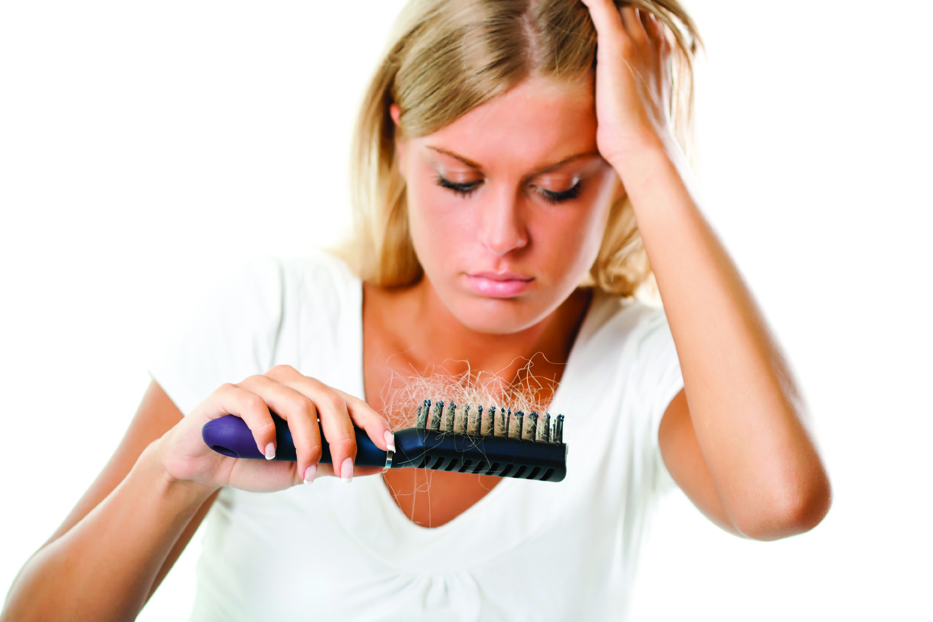Hair loss is becoming as much of a problem for women as it is for men. Some of it is normal, like grass, hair grows in cycles, but not all of it grows at the same rate. About 10% of a person’s hair is either growing or resting at any given time. During resting cycles, hair growth may be minimal.
Like grass, certain things can interfere with hair growth, the most common being the natural aging process. That’s why women watch their hair fail to grow or start thinning. Sometimes it will even produce thicker spots in some places and nothing at all in others.
Other factors that can affect hair growth include exposure to chemicals, illness, improper diet and infections. Certain medications, like birth control pills, can contribute to hair loss.
Most people typically lose between 50 and 150 strands of hair a day, even more on days when the hair is washed. Some people panic when they see any hair in the drain, on their pillow or in their comb or brush, but unless the amount is excessive, there may be no problem at all.
Hair loss in women is spotted differently than in men. While some women may notice a receding hairline, they will more likely notice a growing gap in the width of parting of their natural hair. Depending upon the reason behind the extra hair loss, there may or may not be an easy solution.
Usually, when a woman reports excessive hair loss to her doctor, they will want to run some tests to make certain there is an existing underlying problem like hypothyroidism or an auto-immune deficiency. Doctors will also look for other problems like alopecia, psoriasis or seborrheic dermatitis.
In a normal situation any hair that is lost is replaced by hair of the same size. However, if female pattern baldness is an issue, old hair may be replaced by something much finer. That is an indication that hair follicles may be shrinking. If that’s the case, they may eventually stop growing hair altogether.
Excessive stress, quick and heavy weight loss, normal hormone changes, other medical problems, surgery and vitamin under- or overuse can also lead to hair loss. Using too many chemicals on the hair, like those found in hair dyes, permanents and straighteners, can also be the culprits. Overuse of certain types of styling tools like hair dryers, hot rollers, curling irons or straight irons can damage the hair, causing it to break away from the scalp. Even something as simple as too much washing, rubbing of the hair, or pulling it tight for styling can cause damage, particularly when the hair is wet.
Unfortunately, in some instances hair loss can be permanent with or without treatment. While many medical conditions that lead to hair loss can be treated, there’s no guarantee of a return to normal hair growth patterns. Women who experience cancer, for example, may find their hair grows back thicker than before chemotherapy and radiation. Others, on the other hand, find it doesn’t grow back at all or that it is sporadic in nature.
In cases where chemical or product causes hair fall out, or when drugs cause the problem, hair may grow back once use of those items is stopped. However, that isn’t always the case, and hair may very well grow back differently than it did previously. It depends upon how much damage was actually done to the hair follicle itself. The same can be said for use styling tools and hair styling products.
If stress or quick and heavy weight loss is the cause, a change in diet maybe called for to ensure new hair growth. Diets need to be rich in proteins, fruits, vegetables and whole grains and need to contain fewer food items that are fatty or sugary in nature. Chicken, eggs and fish are high in proteins that are good for the hair. Liver, nuts and soybeans contain much-needed biotin, which helps to thicken the hair shaft. Beef and certain types of seafood like clams, crabs, oysters and salmon are rich in vitamin B5, which is essential for new hair growth, as is the folic acid in brown rice, grains and leaf vegetables.
Vitamin supplements may also help many women grow new hair if the follicle isn’t damaged.
Hair growth products will work for some women. Unfortunately, the treatments can be expensive since they must be continued for an extended period of time in order to ensure continued hair growth.
Hair transplants are very expensive. They don’t always “take” or may require supplemental transplants in the future.
When hair loss can’t be cured, it becomes necessary to look for other methods of dealing with the problem. Some women can afford hair transplants while others are forced to resort to hiding. Many women resort to wigs, hairpieces, extensions, weaves, hats, turbans or bandanas for that purpose. All are feasible, but some are less expensive than others and some work in certain situations but not others.
Wigs provide all-encompassing concealment. It allows a woman to choose the hair colour she wants or to experiment with more than one. She can also opt for varying styles and lengths. With today’s lighter weight, cooler wigs, most women can find something to suit their needs. Of course, synthetic options are considerably cheaper than human hair wigs. The former can be cheap while the latter can cost hundreds of pounds, especially if they’re custom made.
Hairpieces can supplement hair loss that occurs in only certain areas like the hair crown or at the sides. Extensions lengthen the hair, as can weaves. Hairpieces and extensions come in both synthetic and human hair. Most weaves are done only with human hair, although some synthetic options are also available. Costs will vary depending upon the hair and style choice and where the work is done; clip-in extensions and hairpieces can be purchased online or through beauty supply stores and is done by the individual right at home. Weaves require professional assistance and can be very expensive.
Hats and bandanas are relatively inexpensive and can be found almost anywhere. Unfortunately, not all women feel comfortable wearing them.
Some scientists believe that hair loss will continue to grow as a national problem, primarily due to all the outside influences that hair is exposed to. If so, more and more women will face hair loss problems and be looking
for solutions to maintain their natural beauty.

